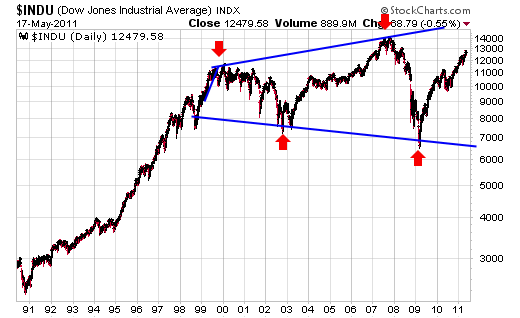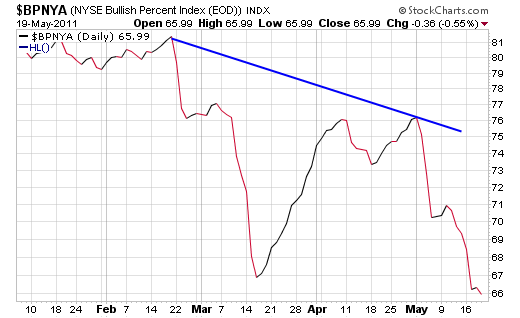In his most recent letter, Richard Russell of the Dow Theory Letters discussed why he is growing increasingly concerned about the state of the bull market. Russell believes there is “technical deterioration” when looking under the hood at the market:
“Late yesterday I was playing around with various formations on the stock averages, and, to my surprise, I came up with the pattern that you see below. Here is the Dow over a period of a decade. What we see here is a so-called “Broadening formation” or “megaphone pattern.” This pattern often appears towards the end of a bull market (as it did in 1919).”
“The broadening formation is made up of five successive reversals, four of which you see on the chart below. The rationale behind the it attempts to “find” the true trend. The broadening pattern represents an semi-hysterical market that first discounts one trend, then changes its mind and discounts an opposite trend.
At the fifth reversal (we’re not there yet) the item rallies to a new highs and then executes a final reversal prior to a collapse. Anything is possible where markets are concerned, and I’m wondering whether what we’re seeing now is a text-book example of a broadening formation. If so, I would expect the Dow to advance to a new high and then reverse violently to the downside.
Another Russell worry — Below we see a chart of the bullish PERCENTAGE of stocks on the NYSE. Here we see a picture of technical deterioration. The bullish percentage is now down to 66.67%, and it is below the March bullish percentage of 67%”
Source: Dow Theory Letters
Mr. Roche is the Founder and Chief Investment Officer of Discipline Funds.Discipline Funds is a low fee financial advisory firm with a focus on helping people be more disciplined with their finances.
He is also the author of Pragmatic Capitalism: What Every Investor Needs to Understand About Money and Finance, Understanding the Modern Monetary System and Understanding Modern Portfolio Construction.



Comments are closed.